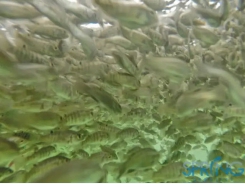Biofloc diets boost catfish growth and performance

The inclusion of biofloc meal in feed has been shown to improve the growth and health status of juvenile African catfish.
African catfish growth rates and health status are improved by replacing up to 20 percent of conventional diets with biofloc meal
So concluded a team of researchers from Bogor Agricultural University, in Indonesia, who have recently completed trials to evaluate the utilisation of biofloc meal as a feed ingredient in enhancing the growth and health status of African catfish (Clarias gariepinus) juveniles.
Bioflocs, which are increasingly used in aquaculture, are created by adding carbon-rich and protein poor materials, such as molasses, to an aquaculture system in order to stimulate the heterotrophic microbial conversion of nutrient waste into microbial biomass through balancing the carbon/nitrogen ratio.
The resulting biomass, known as biofloc, not only contains various microorganisms – such as bacteria, yeast and microalgae – but also micro and macroinvertebrates, extra polymeric substances and suspended solids and it can be used to supplement feeds in situ within a pond system or, alternatively collected and used as a feed ingredient - biofloc meal.
The latter was the subject of this research and the participants set up two experiments – the first looked into the comparative digestibility of biofloc meals produced with tapioca and molasses and concluded that the digestibility of dry matter, protein, lipid and phosphorus of biofloc grown using molasses as the carbon source were considerably higher than in bioflocs produced using tapioca (p < 0.05).
The second trial examined how inclusion of four different levels of biofloc meal – 0, 5, 10 and 20 percent - had on the fish growth performance, feed utilisation, immuno‐haematological response, antioxidant status and robustness against environmental stress.
They concluded that including either 10 or 20 percent of biofloc meal in the diets resulted in higher feed intake, fish growth and final biomass, as well as a better protein efficiency ratio and lower feed conversion ratio (p < 0.05). Furthermore, the red blood cell counts, phagocytic, lysozyme activities and antioxidative capacity were significantly enhanced in the fish provided with a diet containing 20 percent biofloc meal (p < 0.05). Moreover, survival rates following salinity stress tests were higher in the fish which had been fed diets containing the most biofloc meal.
“The present study demonstrated that biofloc meal could be used as a raw material for African catfish juvenile diet and could bring about beneficial effects on the fish growth and health status. A biofloc meal inclusion level of 20 percent resulted in the highest growth performance and health status of African catfish juvenile,” the researchers concluded.
Related news
Tools

Phối trộn thức ăn chăn nuôi

Pha dung dịch thủy canh

Định mức cho tôm ăn

Phối trộn phân bón NPK

Xác định tỷ lệ tôm sống

Chuyển đổi đơn vị phân bón

Xác định công suất sục khí

Chuyển đổi đơn vị tôm

Tính diện tích nhà kính

Tính thể tích ao



 Resolution in dispute between Scottish Salmon Company and…
Resolution in dispute between Scottish Salmon Company and…  New cage concept aims to take salmon sector…
New cage concept aims to take salmon sector…